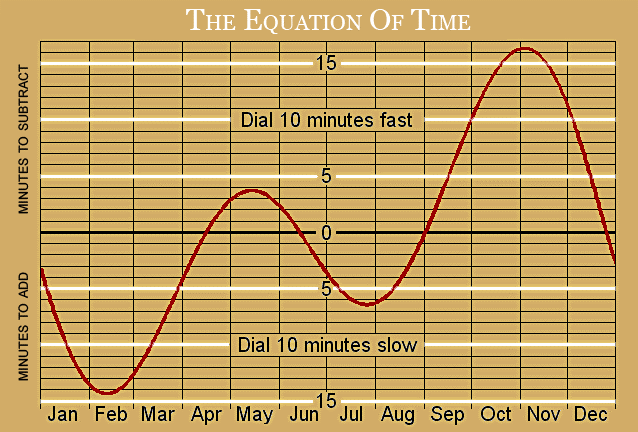Darwin Day, February 12, is probably most famous for being the birthday of Charles Darwin and Abraham Lincoln, both of whom were coincidentally born in the same year (1809). However, what is less well known is that February 12 is also a day of astronomical significance.
As readers of my previous post The Shortest Day will recall, the actual length of a solar day, which is the interval between two successive solar noons, varies through the year. It is at its longest – 24 hours and 30 seconds – around Christmas day and it is shortest at around 23 hours 59 minutes and 38 seconds in mid September. For practical timekeeping purposes, of course, we always take a day to be exactly 24 hours.
This is shown in the graph below.
The graph above shows how the length of a solar day differs from 24 hours. The y-axis shows the difference between the length of a solar day and 24 hours on a given date measured in seconds. So, for example, a value of 10 means 24 hours 10 seconds, 20 means 24 hours 20 seconds, -10 means 23 hours 59 minutes 50 seconds.
As can be seen on the graph, in 2015 there are four dates where the length of a day is 24 hours, rounded to the nearest second. These dates are February 12, May 14, July 26 and November 4.
The equation of time
The solar time, which is the time given by a sundial, will not be the same as the time measured by a clock, which assumes that all days are exactly 24 hours long. The difference between the time measured by a clock and the solar time is called the equation of time.
As discussed previously, in the period of time from November 4 to February 11 all the solar days are slightly longer than 24 hours, which causes the solar noon (the mid point between sunrise and sunset when the Sun is at its highest in the sky) to drift gradually later and later from its average value. On February 12 the equation of time has its lowest value of any day throughout the year. -14 minutes 11.2 seconds to be precise. So, on February 12, the solar time measured by a sundial will lag further behind the time measured by a watch than on any other day of the year.
In London, on February 12, the solar noon which on average occurs at 12:00 will occur just after 12:14 pm. The same is true for anywhere else where there is no longitude correction (see note below).
From February 13 until the middle of May all the days are shorter than 24 hours and the solar noon drifts backward.

Next Post
I hope you’ve enjoyed this short post. My next post will continue my series on cosmology and is about dark matter, the mysterious substance which makes up about a quarter of the Universe, but about which we know very little indeed.
Note
The world is divided into time zones, which are normally a whole number of hours ahead of or behind Greenwich Mean Time (GMT). For example, Manchester, where Mrs Geek and I live, is roughly 2.5 degrees West of Greenwich, but is on the same time zone. Because it is further West, on average the Sun rises and sets later than it does in Greenwich. In Manchester the solar noon will occur at 12:24 GMT on February 12.




[…] The average length of day when calculated over a entire year is just over 24 hours. However, over the course of a year the the actual length of a solar day varies. This variation throughout the year is due to entirely different effects than the slowing of the Earth’s rotation. It is at its longest – 24 hours and 30 seconds – around Christmas day and it is shortest at around 23 hours 59 minutes and 38 seconds in mid September. This is variation is described in more detail in my post 12 Feb 2015: A special day. […]
LikeLike
Wonderful post & blog. So nice to have found you.
LikeLike
Great Post! You make some big concepts and ideas understandable. I appreciate that.
Isn’t it a marvel how attention to detail and accuracy we humans can get with our science research? It does bring me into an optimistic frame of mind for resolving current environmental issues. We really could figure out how to live elegantly, equally, and sustainably on this planet!
LikeLike
Interesting post thanks – I suppose it illustrates the difference between us humans, and our desire for accuracy and predictability, and the rest of the universe that just does it’s own thing whatever – and regardless of our human perceptions of time. We talk of the big bang 13.8 billion years ago, and light years, using our planet’s time it takes to revolve around our sun, a unit of measurement that means a great deal to us living here on earth, but which is of no relevance to the rest of the universe, or universes……….
LikeLike
Interesting and easy to understand for us non-science geeky types. Thanks for the follow!
LikeLike
Short enough post, but kind of dizzying due to info overload, he he!!! Incidentally, I just watched a webinar yesterday that for trivia, mentioned that one day in July will have an extra second. That true? They were in a jovial mood so I wasn’t sure if it was just a joke to break the ice.
LikeLike
Thanks for your comment. We do occasionally add extra seconds. The are called leap seconds and are added in June 30 or December 31. The post on my blog called “The days are getting longer” explains more.
http://thesciencegeek.org/2014/05/27/the-days-are-getting-longer/
The Science Geek
LikeLiked by 1 person
Oh, yes, he did say leap seconds…Thanks! 🙂
LikeLike
Nice post! Feb 12 is also Darwin Day….(:-D
LikeLike
Thanks for reminding me 🙂 I have made a small update to the post to reflect this.
LikeLike